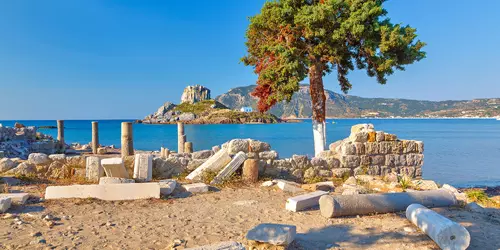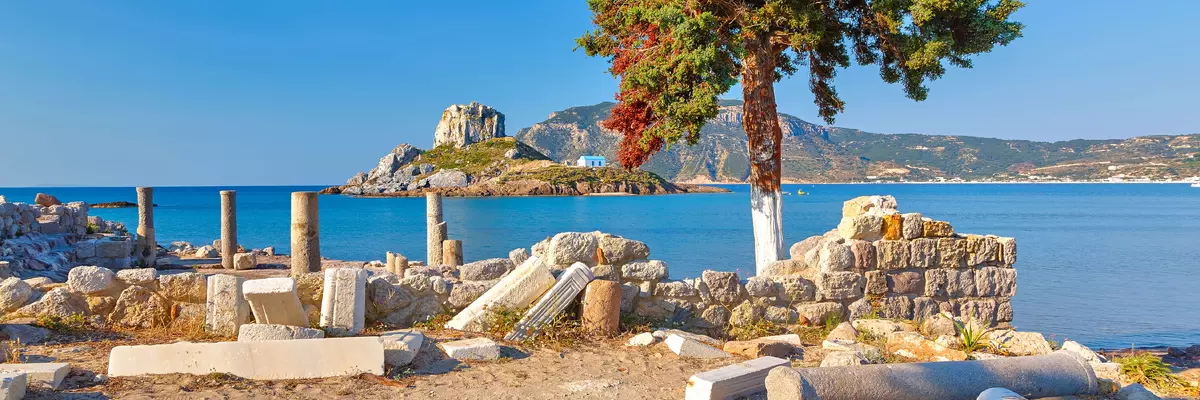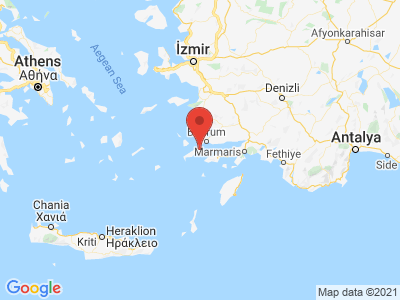Climate Table Kos
Jan | Feb | Mar | Apr | May | Jun | Jul | Aug | Sep | Oct | Nov | Dec | |
|---|---|---|---|---|---|---|---|---|---|---|---|---|
| Max. Temperature | 15° | 16° | 17° | 21° | 25° | 30° | 32° | 33° | 29° | 25° | 21° | 17° |
| Min. Temperature | 7° | 8° | 9° | 11° | 15° | 19° | 21° | 22° | 19° | 15° | 12° | 9° |
| Sun Hours | 4 | 5 | 7 | 9 | 10 | 12 | 13 | 12 | 11 | 8 | 6 | 4 |
| Water Temperature | 17° | 16° | 16° | 17° | 19° | 21° | 23° | 25° | 24° | 22° | 20° | 18° |
| Rain Days | 14 | 10 | 8 | 3 | 3 | 0 | 0 | 0 | 1 | 6 | 7 | 13 |
The climate year of Kos
The island is located just off the coast of Asia Minor and is the third largest island of the Dodecanese archipelago after Rhodes and Karpathos. Kos has a population of about 34,000 inhabitants, with the main town of the same name being Kos with about 19,000 inhabitants. The island has a total area of 290,313 km² with a length of about 42 kilometers and a width of up to 10 km. Its location allows easy access to the Turkish peninsula of Bodrum, which is only five kilometers north of Kos, and the Datça peninsula 15 kilometers south. Neighboring islands of Kos are Pserimos, Kalymnos and Astypalea. The main season in Kos is from May to October with temperatures up to 31°C.
General information about Kos
Kos offers a number of attractive sights and impressive landscapes. Worth seeing is the important archaeological site of the ruins of Asklepieion, once an ancient sanctuary. Also, the famous St. John's fortress of Neratzia in the town of Kos is truly worth a trip. The fortress was built from the 14th to the 16th century and was commissioned by the Grand Master of the Order of St. John Helion de Villeneuve in the middle of the 14th century. Other attractions include the plane tree of Hippocrates, excavations in Kos Town, such as Agora or the House of Europe, the Embros thermal baths located in the southeast of the island, the salt lake Alykes near Tigaki, the abandoned villages of Agios Dimitrios and Palio Pyli with castle ruins, as well as the peacock forest and fortress Andimachia. Especially the Embros thermal baths, 12 kilometers from Kos Town, are a popular destination for tourists. From a crevice flows about 49 ° C hot, sulfurous water, which is collected in a basin made of rock and serves visitors for recreation and healing.
Tourism Kos
Climatically, the island offers very pleasant conditions. The two warmest months on the island are July and August with up to 31°C and up to 13 hours of sunshine. January, on the other hand, is the coldest. Here the minimum temperature reaches 8.8°C and the maximum 13.6°C and there is a precipitation of up to 91mm with 14 rainy days. February is still very similar to January, but there are only 10 rainy days. From March to May, the temperature rises steadily, with precipitation also decreasing significantly. While the maximum temperature in March is 15°C, it is already 23.3°C in May. April and May each have 3 rainy days and 9 and 10 hours of sunshine, respectively. In spring you can observe the blooming of the flora all over the island. May is the beginning of the main season. June to September are very warm months. In these months the precipitation is almost zero and the water temperature reaches up to 25°C in August. From October it gets cooler again, so that in December only a maximum of 14.8°C is reached and there is a precipitation of up to 119.9mm.


